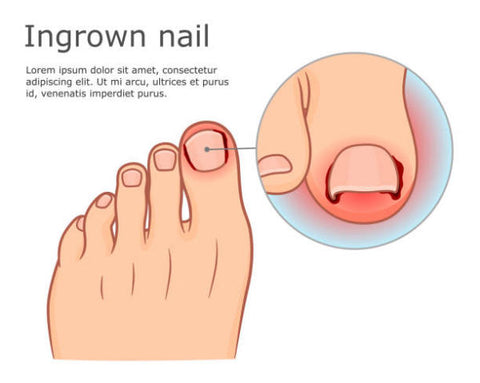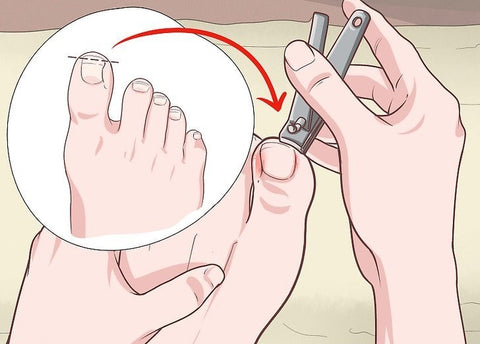In today's world, individuals often turn to the internet for solutions to various health concerns. One common issue that people seek guidance on is overgrown toenails. Nghia Nippers aims to provide users searching for information on overgrown toenails with a comprehensive overview of its causes, remedies, prevention, and overall foot health. Addressing both physical discomfort and appearance, this article explores the relationship between overgrown toenails and foot well-being.

1. Impact of ingrown toenails on comfort and appearance
Ingrown toenails can have a profound impact on both an individual's comfort and their overall appearance. The discomfort stemming from an ingrown toenail can range from mild irritation to intense pain, making everyday activities like walking or wearing shoes a source of distress. Furthermore, the visual appearance of an ingrown toenail can lead to self-consciousness, affecting one's confidence to expose their feet in social or public settings. This combination of physical discomfort and diminished self-esteem underscores the significance of addressing ingrown toenails promptly and effectively.
2. Causes of overgrown toenails
Overgrown toenails can stem from various underlying causes, ranging from improper nail care practices to lifestyle factors that influence their growth patterns. Understanding these causes is essential in effectively managing overgrown toenails.
2.1 Identifying common causes and triggers
Overgrown toenails often arise from a variety of common causes and triggers. Improper nail trimming techniques, such as cutting the nails too short or rounding the edges too much, can encourage the nail to grow into the surrounding skin. Additionally, tight or ill-fitting footwear can exert pressure on the toes, leading to the distortion of nail growth patterns. Injuries to the toenail or toe can also result in irregular growth as the nail attempts to heal itself. Recognizing these common causes is the first step in preventing and managing overgrown toenails.
2.2 Lifestyle factors contributing to toenail overgrowth
Lifestyle choices play a significant role in toenail overgrowth. Individuals who engage in activities that repeatedly traumatize the toes, such as playing sports that involve frequent stopping and starting, are more susceptible to developing ingrown toenails. Similarly, occupations that involve prolonged periods of standing or wearing tight shoes can contribute to the problem. Poor foot hygiene, characterized by inadequate cleaning or moisturizing of the feet, can also increase the likelihood of toenail overgrowth. By identifying and addressing these lifestyle factors, individuals can take proactive measures to prevent the occurrence of overgrown toenails and maintain optimal foot health.

3. Trimming Overgrown Toenails
For those dealing with overgrown toenails, proper trimming is a key step in addressing the issue. Trimming the nails carefully can help alleviate discomfort and prevent further complications. While detailed instructions are best provided by a healthcare professional, ensuring a straight across cut and avoiding rounding the edges can promote healthier nail growth.
- READ MORE: CHOOSING THE GOOD TOENAIL CLIPPERS.
4. Preventing Excessive Toenail Growth
Managing toenail growth to prevent overgrowth is crucial for maintaining foot health and comfort. By understanding the contributing factors and implementing preventive measures, individuals can promote healthy nail growth and minimize the risk of discomfort and complications.
4.1 Factors contributing to overgrown toenails
Several factors can contribute to the development of overgrown toenails:
- Genetics: Genetic predisposition can influence nail thickness and growth rate, making some individuals more prone to overgrown nails.
- Medical Conditions: Certain medical conditions like diabetes and circulatory disorders can affect nail health, leading to irregular growth patterns.
- Foot Trauma: Injuries to the toes or repeated trauma, such as from tight footwear or activities like running, can disrupt proper nail growth.
- Improper Footwear: Ill-fitting shoes that crowd the toes or place pressure on them can contribute to overgrown toenails.
4.2 Tips to prevent and minimize toenail overgrowth
To promote healthy nail growth and prevent overgrowth, consider these tips:
- Proper Footwear: Wear shoes that fit well and provide ample space for your toes to prevent pressure and encourage natural nail growth.
- Regular Trimming: Trim your toenails straight across to discourage ingrowth. Avoid cutting them too short or rounding the edges.
- Foot Hygiene: Maintain good foot hygiene by cleaning your feet regularly and keeping them dry. Moisturize the nails and surrounding skin to prevent brittleness.
- Protective Measures: When engaging in activities that increase the risk of toe trauma, such as sports, consider using protective footwear or gear.
- Professional Consultation: If you notice signs of overgrown toenails or are at risk due to medical conditions, consult a podiatrist or healthcare professional for guidance.
- Healthy Lifestyle: Adopt a healthy lifestyle that includes a balanced diet and regular exercise to promote overall foot health.

5. Natural Remedies for Soothing Overgrown Toenails
When dealing with overgrown toenails, natural remedies can provide temporary relief and promote healthier nail and skin conditions. However, they are not a substitute for professional medical advice. Some natural remedies include:
- Warm Foot Soaks: Soaking feet in warm water softens nails and skin, making it easier to gently push back ingrown edges. Adding Epsom salt can enhance soothing effects.
- Tea Tree Oil: Diluted tea tree oil applied to the affected area offers antibacterial and antifungal properties, reducing inflammation and preventing infection.
- Apple Cider Vinegar: A diluted foot soak with apple cider vinegar eases discomfort and inflammation. Its acidity helps prevent infection.
- Lavender Oil: Mixing a few drops of lavender oil with a carrier oil and gently massaging onto the area soothes irritation due to its calming properties.
- Cotton Ball or Floss: Placing a cotton ball or floss under the ingrown nail edge can lift it slightly, aiding in preventing further ingrowth. Caution is needed to avoid irritation.
- Aloe Vera Gel: Applying pure aloe vera gel can soothe the skin around the affected nail due to its anti-inflammatory properties.
6. Professional vs. DIY treatment for overgrown toenails
Dealing with overgrown toenails requires thoughtful consideration of whether to opt for professional treatments or try do-it-yourself (DIY) methods. Both approaches have their merits, and choosing the right one depends on the severity of the condition and personal preferences.

6.1 Considering professional treatments
In cases of persistent discomfort, severe pain, or when overgrown toenails are accompanied by infection, seeking professional treatment is highly recommended. Podiatrists, medical professionals specializing in foot care, can offer various options:
- Nail Trimming: A podiatrist can safely trim overgrown nails to relieve discomfort and minimize the risk of further complications.
- Partial or Complete Nail Removal: In severe cases, where infection or deformity is present, a podiatrist may suggest partial or complete nail removal or the use of a nail nipper to provide relief and promote healthy regrowth.
- Antibiotics or Antifungal Medications: If infection is present, a podiatrist can prescribe antibiotics or antifungal medications to treat the underlying issue.
6.2 Effective methods for at-home toenail care
While professional care is advised for severe cases, mild cases of overgrown toenails can often be managed at home. Here are some effective methods for DIY toenail care:
- Warm Foot Soaks: Soaking your feet in warm water can soften the nails, making them easier to trim and providing temporary relief.
- Proper Trimming: Trim the nails straight across and avoid rounding the edges to prevent ingrowth. Use a professional toenail clippers and be cautious not to cut them too short.
- Cotton Ball or Floss: If the nail edge is slightly ingrown, you can gently lift it using a cotton ball or floss placed underneath.
- Topical Ointments: Over-the-counter antibiotic ointments can be applied to reduce the risk of infection.
- Wearing Comfortable Shoes: Choose well-fitting shoes with sufficient toe room to prevent pressure on the toes.
7. Daily toenail care routine: promoting healthy toenails
Maintaining healthy toenails requires consistent care and attention. By establishing a daily toenail care routine, you can promote strong, comfortable, and attractive nails. This routine focuses on prevention, cleanliness, and proper trimming techniques.
7.1 Establishing a simple and effective routine
Creating a daily toenail care routine doesn't have to be complicated. Here's a simple yet effective routine to follow:
- Daily Inspection: Take a moment to examine your toenails for any signs of overgrowth, ingrown edges, or infections.
- Keep Them Clean: Wash your feet daily with warm water and mild soap. Gently cleanse the area around the nails to prevent debris buildup.
- Moisturize: After cleaning, apply a moisturizer to your feet to keep the skin and nails hydrated.

7.2 Maintaining healthy toenails on a regular basis
Consistency is key to ensuring the health of your toenails. In addition to your daily routine, consider the following practices to maintain healthy toenails:
- Proper Trimming: Trim your toenails regularly, preferably after a warm foot soak. Cut them straight across and avoid rounding the edges.
- Choose Proper Footwear: Wear comfortable shoes that fit well and provide sufficient space for your toes.
- Limit Pedicures: If you opt for professional pedicures, make sure the tools are properly sterilized to prevent infections.
- Avoid Nail Biting: Refrain from biting your toenails, as this can damage the nail bed and lead to infections.
- Protect Your Feet: When in public places like pools or gyms, wear appropriate footwear to prevent exposure to fungi and bacteria.
- Address Issues Promptly: If you notice any changes or discomfort in your toenails, seek professional advice promptly.
Seeking information on overgrown toenails reveals a genuine concern for both physical well-being and appearance. By understanding the causes, remedies, prevention techniques, and the impact on overall foot health, individuals can make informed decisions to manage and prevent the issue of overgrown toenails. Prioritizing regular foot care, with the assistance of quality tools like Nghia Nippers, not only enhances comfort and confidence but also contributes to maintaining a healthy and active lifestyle.
>>> Watch now: What is an ingrown toenail













